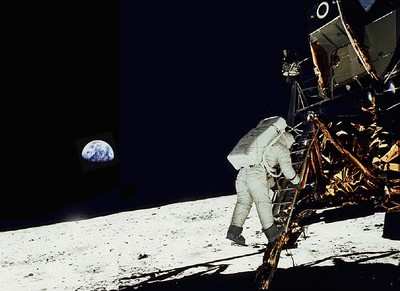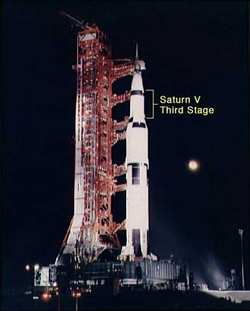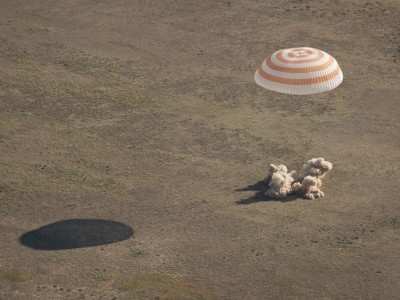50 Years Ago, JFK Challenged America To Reach The Moon
Aero-Analysis/Opinion By Wes Oleszewski
May, 25th, 1961, exactly half a century ago, President John F.
Kennedy stood in front of a joint session of the United States
Congress and openly challenged our nation to land a man on the moon
and return him to the earth within a decade. At that moment very
little of what would be needed to get a human onto and back from
the lunar surface existed. Engineers had not even agreed on the
method by which to fly there. The United States had only one
man-rated booster, the Mercury Redstone, and it did not even have
the power to place a spacecraft into orbit. NASA's administrator,
James Webb, had only been in office for three months and six days
when the lunar challenge was made and nearly every engineer who
worked on Project Apollo had yet to be hired.

Kennedy Delivers Moon Challenge 5.25.1961
President Kennedy's speech contained more than just the
challenge to go to the moon. In fact the address was titled the
"Special Message to the Congress on Urgent National Needs." It
covered areas such as economic and social progress at home and
abroad, national "Self Defense," our military and intelligence
shield, civil defense and so on. Overall, the speech had nine
subjects and "Space" was the ninth. When Kennedy got there, he not
only made the challenge, but he also detailed the cost and asked
the Congress specifically for the needed funds. He also warned
about the lead that the Soviets had in the spaceflight capability.
Then he went beyond the objective of landing on the moon and
pointed toward the future. He said, in part: "I believe we possess
all the resources and talents necessary. But the facts of the
matter are that we have never made the national decisions or
marshalled the national resources required for such leadership. We
have never specified long-range goals on an urgent time schedule,
or managed our resources and our time so as to insure their
fulfillment."
He then went on to say: "Let it be clear--and this is a judgment
which the Members of the Congress must finally make--let it be
clear that I am asking the Congress and the country to accept a
firm commitment to a new course of action, a course which will last
for many years and carry very heavy costs: 531 million dollars in
fiscal '62--an estimated seven to nine billion dollars additional
over the next five years. If we are to go only half way, or reduce
our sights in the face of difficulty, in my judgment it would be
better not to go at all.

"It is a most important decision that we make as a nation. But
all of you have lived through the last four years and have seen the
significance of space and the adventures in space, and no one can
predict with certainty what the ultimate meaning will be of mastery
of space.
"This decision demands a major national commitment of scientific
and technical manpower, materiel and facilities, and the
possibility of their diversion from other important activities
where they are already thinly spread. It means a degree of
dedication, organization and discipline which have not always
characterized our research and development efforts. It means we
cannot afford undue work stoppages, inflated costs of material or
talent, wasteful interagency rivalries, or a high turnover of key
personnel.
"New objectives and new money cannot solve these problems. They
could in fact, aggravate them further--unless every scientist,
every engineer, every serviceman, every technician, contractor, and
civil servant gives his personal pledge that this nation will move
forward, with the full speed of freedom, in the exciting adventure
of space."
With this speech, JFK ignited moon fever in the United States.
Engineering degrees began to be the thing to get and the nation
began to build its pride around its space program. There was no
talk of can't or won't and NASA management was decisive in the
program's direction. Perhaps the only flaw was the rush to beat
Kennedy's deadline. At its peak, NASA's funding was about 5% of the
national budget. Estimates are that some 350,000 people worked in
one way of another on the Apollo program. From the guys who poured
the cement that made the foundations of the needed facilities to
the women who sewed the space suits- thousands of contractors got a
piece of JFK's challenge. Even when the Apollo 1 fire cost the
lives of 3 astronauts and caused the program to stumble, the
quality and quantity of the engineering that could be tapped set
the program back on track. Thus on July 20, 1969 Neil Armstrong and
Buzz Aldrin landed on the moon and the within four days they, along
with Mike Collins returned safely to the earth.

So… where are we now, 50 years after JFK's challenge? In
just a few months the final Space Shuttle will be launched from the
Kennedy Space Center. The instant that the bolts blow and it leaves
the ground, for the first time in three decades the United States
will have ZERO autonomous means of sending astronauts into space.
Additionally, for the first time in 50 years, the US will have no
stated, mandated objective in space. We will in fact, no longer be
a space fairing nation.
Our only access to a $100 Billion dollar asset, the
International Space Station, a platform largely paid for by US tax
dollars, will be by way of buying seats aboard the Russian Soyuz
spaceflight system- which was developed by the Soviet government.
Those seats, which were in the past sold to "tourists" for $22
million each, and have during shuttle operation been sold to NASA
for as much as $55 million. Recently the Russian announced that now
those same seats will cost NASA $64 million each and after 2014 the
price may have no contractual limit.

Politically, we find our nation's human spaceflight program not
only at the mercy of the Russians, but neutered by our own leaders.
We have a president who is openly dismissive of lunar exploration,
who wants all of NASA's human spaceflight earth orbital
responsibility immediately handed over to private "commercial"
start-up companies and who seems to believe the best way for NASA
to explore beyond earth orbit is to sit around and study the issue
for at least the next five years, or more. Although the Congress
has rejected the president's human spaceflight notions and has
mandated that a new heavy lift manned booster program begin last
January, the president has an ace up his sleeve that he is using to
gum up the works. Serving at the pleasure of the president is his
NASA administrator, Charlie Bolden. Although Congress dictates to
NASA what the agency must do, the implementation, or in this case,
non-implementation or those actions are under the direction of the
administrator- who serves the president. Thus, nearly nothing has
been done by the agency to head in the direction that the Congress
has required by law.
The contrasts of the nation's human spaceflight program between
1961 and 2011 are polar opposite. In 1961 we had a president who
set the nation on a clear path, toward a clear goal with the intent
to make America the leader in human spaceflight as well as to
inspire wide spread technical innovation and bring out the best of
the skills and minds of the people of the United States. He gave
that task to a NASA administrator who said can-do, will-do, must-do
and proceeded to make it happen. In 2011 we have a president who,
in his last two budget requests, set no clear goal for NASA, or the
nation in the area of human spaceflight and set no clear direction
plus seems fully intent to surrender the nation's leadership in
human spaceflight to the Russians and the Chinese. He is served by
a NASA administrator who, while testifying in front of Congress
said "…if you asked me today to go to Mars, I'd tell you I
can't do it." One wonders what the future may have been, if James
Webb had established such a can't-do attitude.

Thus, 50 years ago our nation started on a bold path that
developed the technology that would take us to the moon, establish
the Skylab workshop and later went on to develop and operate a
Space Shuttle- only to have it all frittered away in a leadership
void. Although blame for our current waste of a half century of
spaceflight efforts and benefits must be spread across the later
Bush administration as well as the current Obama administration,
the current president had the opportunity to stand up, be bold and
inspire the nation with a renewed clear direction and goal in human
spaceflight.
Instead he voted "present."
 ANN's Daily Aero-Linx (04.15.24)
ANN's Daily Aero-Linx (04.15.24) Classic Aero-TV: 'No Other Options' -- The Israeli Air Force's Danny Shapira
Classic Aero-TV: 'No Other Options' -- The Israeli Air Force's Danny Shapira Aero-News: Quote of the Day (04.15.24)
Aero-News: Quote of the Day (04.15.24) Airborne 04.16.24: RV Update, Affordable Flying Expo, Diamond Lil
Airborne 04.16.24: RV Update, Affordable Flying Expo, Diamond Lil ANN's Daily Aero-Term (04.16.24): Chart Supplement US
ANN's Daily Aero-Term (04.16.24): Chart Supplement US







